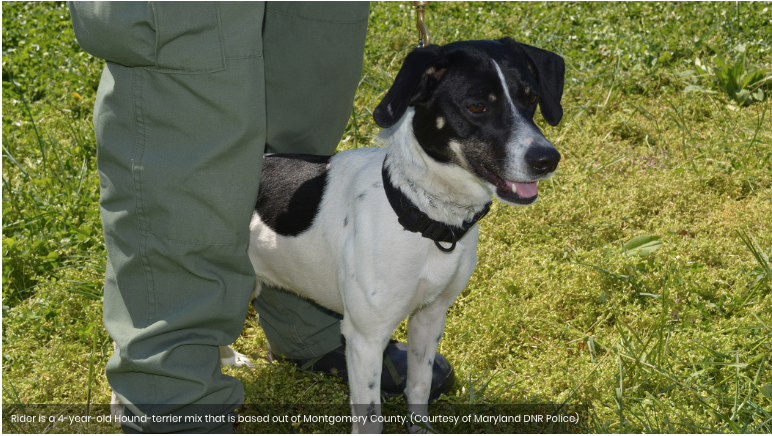 According to the square Army green patch on the back of his harness, this officer’s “Beast Mode” is always “ON.” Rider, a 30-pound K-9 assigned to the state’s Natural Resources Police, may offer the department more brains than brawn.
According to the square Army green patch on the back of his harness, this officer’s “Beast Mode” is always “ON.” Rider, a 30-pound K-9 assigned to the state’s Natural Resources Police, may offer the department more brains than brawn.
For the hound-terrier mix and his trainer, Sgt. Ben Lillard, the insignia demonstrates that his 30-pound frame does not hinder his ability to perform regular patrol duties.
Rider is one of four Maryland Department of Natural Resource Police dogs, which are specially selected and trained to execute tasks like detecting poached wildlife, tracking violators, searching and locating missing individuals and detecting human remains.
Maryland’s Department of Natural Resource K-9 program, which began in 1994, seeks dogs that have a strong drive — the most important trait.
Sgt. Devin Corcoran said that any dog that the Department of Natural Resources Police acquires must combine a high level of determination with a playful demeanor.
A dog that is willing to crawl under a parked car to retrieve a toy is preferred over a dog that does not demonstrate the initiative, said Virginia’s Department of Game and Inland Fisheries Conservation Police Officer Jim Patrillo, handler of a 3-year-old black Labrador retriever named Bailey, said.
“Everything we do with our dogs is toy-rewarded,” Patrillo said. “When we test dogs, puppies, we look for a high energy and a toy drive.”
Maryland’s Department of Natural Resources operates under similar measures.
“If they have drive and motivation … and some intelligence, we can train them,” Corcoran said.
Along with Rider, the Department of Natural Resources Police cares for and maintains three other dogs, including two yellow Labs, Beacon and Badger, and a Chesapeake Bay retriever, Ruckus.
Prior to 2016, Maryland’s Department of Natural Resource’s K-9 units received training from locations in Florida, Kentucky and Indiana, according to Corcoran.
Indiana Conservation Officer Jeffrey Milner has instructed about 72 dogs, including three from Maryland, since 1997.
In 2014, Milner trained Corcoran, who is one of three conservation officers who have attended Milner’s training.
Milner, handler of an 11-year-old Labrador retriever, breaks his training regimen down into three different phases, including mantracking, wildlife detection and article search, with each lasting approximately three weeks.
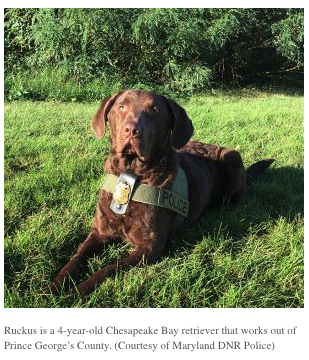 Corcoran, who completed a 2015 Train the Trainer Course with K2 Solutions in Southern Pines, North Carolina, due to a contribution from the Humane Society of the United States, said that he brought a similar approach to Maryland.
Corcoran, who completed a 2015 Train the Trainer Course with K2 Solutions in Southern Pines, North Carolina, due to a contribution from the Humane Society of the United States, said that he brought a similar approach to Maryland.
Maryland’s training usually lasts about nine weeks and varies from 400 to 480 hours, according to Corcoran.
Although the dogs enjoy searching for and locating wildlife, mantracking is the most difficult part of the training, according to Milner.
“Most dogs track naturally, but don’t track humans naturally,” Milner said.
Dogs typically follow a scent but can often get redirected, compelling the handler to reassess the situation and give the canine a moment to regather the scent, according to Milner.
“Reading the dog is key,” Milner said. “(Handlers) learn every sign that the dog gives them.”
Maryland’s canine training has since transpired in-house — for reasons including proximity and cost, and it allows the department to tailor the training to Maryland’s geofactors.
Although the department’s four dogs are located on the Eastern Shore and in Montgomery, Prince George’s and Baltimore counties, Corcoran said that he does not uniquely train each dog for its region, and that the dogs can travel state-wide.
When the dogs locate an item or person of interest — what Corcoran classifies as the “ultimate goal” — Maryland’s Department of Natural Resources trains them to use a passive action that is easily visible to indicate the find, such as sitting or laying down.
Corcoran trains the dogs to execute a passive action instead of an aggressive one, such as scratching or biting, to ensure that the dog and the evidence or item of interest remain safe.
The canines are then rewarded for their work by the department’s handlers, granting them play time with a toy of their choice.
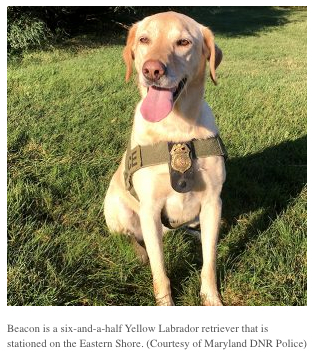 Milner said that he recommends handlers to utilize a variable reward system, which causes a build up of anticipation and a rush of endorphins.
Milner said that he recommends handlers to utilize a variable reward system, which causes a build up of anticipation and a rush of endorphins.
“Whatever motivates the dog … is what I want the handler to use,” Milner said. “Nationwide, KONG is the toy of choice — probably the dog’s favorite choice.”
KONG toys are made out of rubber that can withstand lengthy chewing and can be filled with snacks.
The K-9’s training program is based around positive reinforcement and high praise — tactics that are most effective when instructing dogs, according to Milner.
Two of the department’s dogs — Rider and Ruckus — arrived as donations from county animal shelters, while Beacon was donated by a family.
Badger, the Natural Resource cadaver, or human remains, dog was purchased for $700 from private yellow Labrador breeder Scott Stapleford in Delaware.
The Maryland State Police can pay more — anywhere from $3,500 to $9,000 based on the type of dog, where it is procured, the length of warranty, and the amount of training the dog may already have, according to the department. The state police have 42 dogs, including German shepherds, Belgian Malinois, Labrador retrievers, bloodhounds and a springer spaniel.
The state police obtained one German shepherd from a rescue facility, according to the department.
Maryland State Police dogs are trained in both police activities and detection of material, including narcotics and explosives, according to Brenda Carl, public affairs officer for the Maryland State Police. 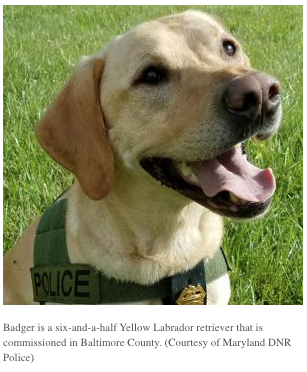
Their training is also done in house with department trainers and lasts between 12 and 20 weeks depending on the dog and its handler, according to the department.
Milner also cited the execution of obedience as another factor in the longer training of police dogs.
After tearing his right cranial cruciate ligament, which is similar to an anterior cruciate ligament in humans, in June, Rider tore his left cranial cruciate ligament in October — not an uncommon occurrence or dogs, the department said.
But after Rider makes a full recovery — as the department expects — Beast Mode will be back on duty, tracking down illegal activity involving Maryland’s natural resources.
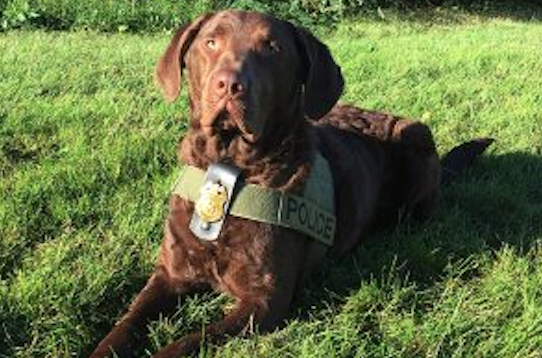


Write a Letter to the Editor on this Article
We encourage readers to offer their point of view on this article by submitting the following form. Editing is sometimes necessary and is done at the discretion of the editorial staff.